My first foster dog got adopted and I want to share what I learned along the way.
Should I Foster a Dog?
When I told friends about my plans to foster a dog, I usually got one of two responses – either they ask “how does that work”, or they laugh and say “yeah, foster fail”! (A foster fail is when you get too attached to the dog and can’t give it up.)
So, I think the first question to ask yourself is “Will I be able to give up this dog, even if it takes several months to get them adopted?” I certainly needed to do some soul-searching to determine if fostering a dog was the right thing for me. I wrote a brief story on medium.com about how I decided I could foster a dog without failing.
Even if you decide that you can handle giving the pup up, there are many other things to think about. One good resource I used to get insight into what to expect was the /fosterdog sub-reddit on reddit.com. There you can read about people’s success stories, and about why some people are struggling and, in some cases, having to return their foster dog.
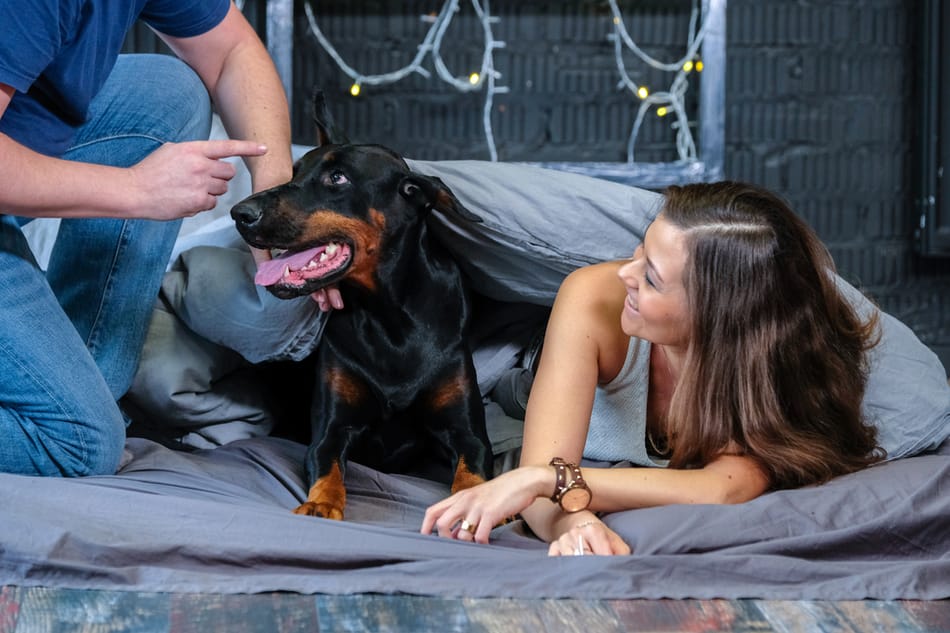
Photo Courtesy of: Doberman Planet
One thing to consider is the other people in your household. Even if the foster pup is intended to be your project, this dog will affect everyone else in your home and there’s a good chance it will affect them more than you think. For example, you might find that having the foster dog keeps you from sleeping in the same room as your partner, or that they have to deal with the dog while you are out of the house. Or perhaps the dog will bark a lot and it really annoys your roommate.
You should also give serious consideration as to whether or not you really have the time and energy (both physical and emotional) to deal with a foster dog. Since I have two other dogs I didn’t really think a third would make that much difference in my routine. But it really did, and I often found myself overwhelmed. I’ll discuss more about that later in this article.
Another thing to think about is whether your home is conducive to fostering. People often ask the question “can I foster a dog in an apartment?” The answer is “yes”, but…”! If you live in an apartment you need to be extra careful about the dog(s) you choose to foster. Of course there is the obvious limitations of what your landlord will allow, but that’s just the beginning. There are other questions to consider. What will happen if you get a dog who barks all the time while you are gone? Will you realistically be able to give the dog as much exercise as it needs? What will happen if the dog isn’t adopted before your lease is up?
I certainly don’t want to scare anyone away from fostering. There are so many dogs that out there that need saving! But I think success is much more likely if you go into the situation understanding how it will affect your life.
So, how does fostering a dog work?
A lot of people have asked me the question “how does fostering a dog work?” The information below depicts the typical fostering situation when you go through a rescue organization.
As you are doing your research you’ll find a lot of non-profit organizations whose mission it is to find unwanted dogs a loving home. Some of these organizations will accept owner surrenders and sometimes they take in strays. But, for the most part, these rescues are getting dogs from shelters. Often they focus on shelters where dogs will be euthanized and/or shelters that don’t offer public adoptions. Some rescues have a facility where they keep the dogs. In some cases the “facility” is just the home of the organization’s director. But the rescue I’m working with is strictly foster-based (although the director acts as a foster to many of the dogs). Foster-based rescues seem to be the most common kind these days.
So, the way it works with the foster-based rescues is that they either have a relationship with various shelters that will contact them, and/or they work with volunteers who go into shelters to identify adoptable dogs in need. Also, occasionally, rescues are contacted by animal control departments when a large number of dogs are found in one place living in inhumane conditions. In those cases, there are too many dogs to be taken to one shelter, so the rescues step in to find emergency foster homes.
In order to find both foster homes and permanent homes for the dogs it represents, rescue organizations post photos and descriptions of the dogs on their website, social media pages, and online databases (such as petfinder.com). It’s through these places that you can find dogs that need foster homes. But if you are looking for a dog to foster, be sure to check out the foster organization that you’ll be working with. What is expected of you will vary between rescues. Look for how long of a commitment they expect you to make to a particular dog, and understand exactly what they will provide, what they will reimburse you for, and what they expect you to provide. I’ve heard that some rescues provide the foster family with everything, including toys and food. However, the organization I’m working with only pays for vet bills and medication.
Each rescue organization has its own requirements and application process to screen prospective fosters. But generally, these rescues just want to make sure that applicants are responsible people who have the ability to care for a foster dog. Once you are approved by a rescue group, you let them know which dog(s) you are interested in fostering. Once your foster dog is identified, and you’ve signed the rescue’s contract, the next step is getting the dog to you. You may be asked to pick the pup up from a shelter, or the rescue may have a volunteer who will transport the dog to you or to an agreed upon central location.
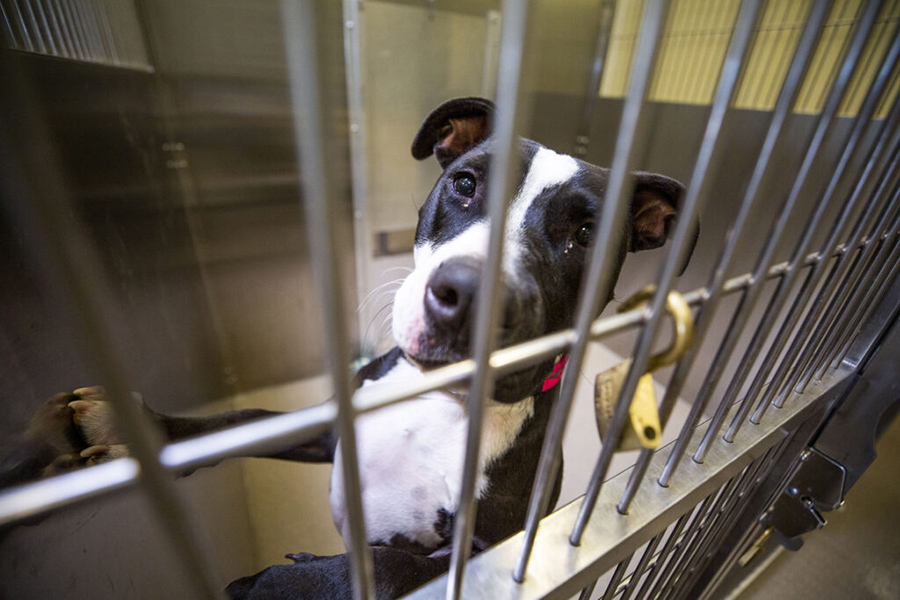
Photo Credit: Kevin J. Beaty/Denverite
Once you have the dog, you would then coordinate with the rescue to get your dog everything they need in order to be adoptable. If they haven’t already been treated by a vet, that will be the first step along with getting them microchipped. You will also be asked to evaluate their temperament so that they can be property advertised and placed. You may be required to provide some basic training and work on any behavioral issues. Once they are deemed to be ready for adoption, the rescue will advertise the dog on the internet, but they will likely ask you to help promote the dog by putting them on social media, taking them to adoption events, and/or taking them out in public wearing an “adopt me” scarf.
When the rescue you’re working with receives applications for your foster dog, they will likely ask for your input as to whether the applicant is a good fit for the dog. You may also be asked to talk to applicants to better determine whether or not they are a good match. If there is more than one applicant, you will likely have to determine which one is the best choice for your foster pup. Once a choice has been made, you’ll arrange to have the prospective adopter visit the dog either at your home, or in a public place, if that is your preference. If the adopter lives near you and the dog is already attached to you, you might choose to have the adopters visit the dog a few times before they take him/her home. However, if the adopter lives very far from you, they will probably want to take the dog the same day they meet them. I believe that most rescue organizations give you the final say in whether or not (and when) an adopter make take the dog home.
So, that’s typically how the process of fostering a dog works. How smoothly and quickly it all happens really depends on the dog you choose to foster and the rescue organization you are working with. In the next section below, I provide a detailed story of my experience fostering a dog for the first time. If you prefer to skip the story, you can click here to go to the end of the article where I’ve provided a list of the pros and cons of fostering a dog.
My Story Fostering a Dog for the First Time
It was fun, rewarding, exhausting, and sometimes a little stressful! I felt a mixture of sadness and relief as I sent my foster dog off with his furrever family. Below is my story, followed by what I felt were the pros and cons of fostering a dog.
I chose to foster with Ewenity Farms (pronounced “Unity”) because they are a Florida herding dog rescue and cattle dogs and border collies are my favorite breeds. I felt that for my first fostering experience it was best to get a dog that would likely be adopted quickly just in case I didn’t really like fostering. So I focused on dogs that were young and had no known behavioral issues. One of the dogs that I was considering (Jackson) looked to be a one year old pure-bred cattle dog (blue-heeler) who was taken in by a good samaritan. This dog was being kept in the person’s home in Texas until he could be transported to a foster in Florida. The other dog that I was interested in was named Fidget and he was in a rural shelter in north Florida. This dog was estimated to be a 7 month old border collie mix.
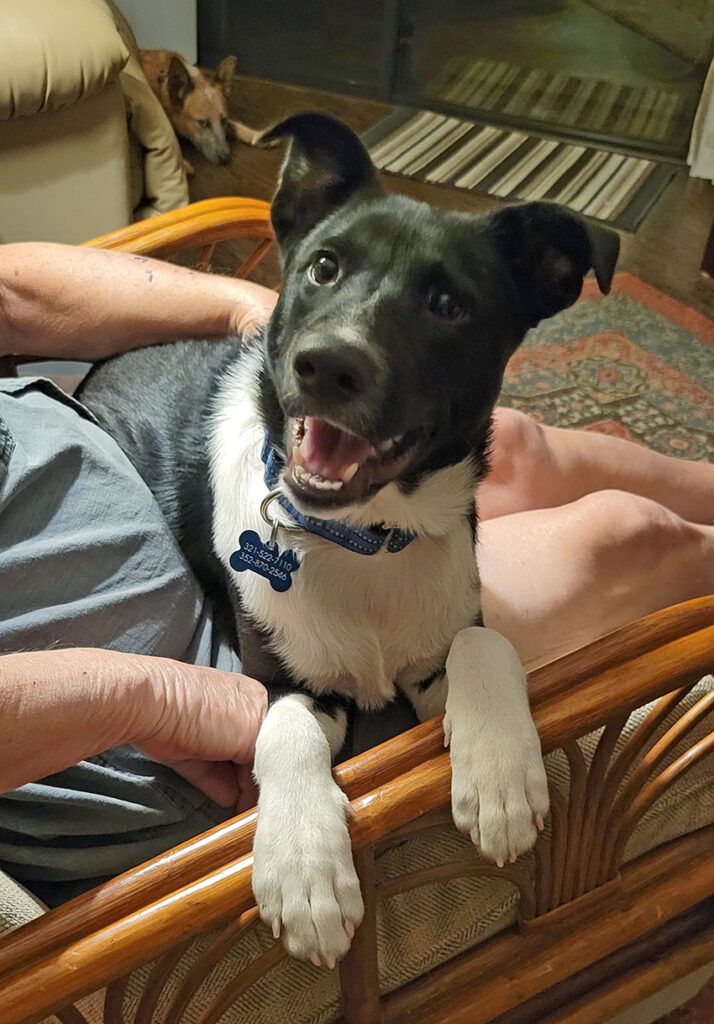
When I told the rescue which dogs I was interested in, they encouraged me to take the dog in the shelter because he was in a higher-need situation. I agreed and arranged to get the dog the next day, which was a Friday. The rescue tried to find someone to transport the dog half-way to me, but no one was able to do it that day, and I didn’t want Fidget to have to spend another weekend at the shelter. So I drove 3 hours to pick him up.
The shelter consisted of two buildings – an office with an attached warehouse, and a kennel that appeared to hold about 20 or 30 dogs. I didn’t get to go in the kennel since they brought Fidget out to me, but it appeared to be mostly open air with the dogs on concrete with nothing but water and food bowls. In my initial meeting of Fidget he certainly lived up to this name. He was so incredibly excited to be outside that he could barely be contained. Thankfully, he was only 28 pounds, or I’m not sure we could have gotten him into the harness that I brought. He looked and acted healthy but he was filthy and smelled strongly of old urine. He seemed a little scared about going into the car and being strapped in, and the first thing he did was make a screeching sound that I’ve never heard come out of a dog before. I was afraid that it was going to be a very long, miserable ride home! But thankfully, as soon as I began driving and talking to him in a soothing voice, he calmed right down. Every once in a while I handed a small treat to him behind my back. What was supposed to be a 3 hour ride home turned into 4 hours due to weather and traffic, but Fidget was a trooper. He slept some and spent a lot of time chewing on the Nylabone I brought for him. When we finally got home my husband, Mark, went to get him out the back seat, but Fidget wasn’t budging. I had to go and get him. Apparently, the 4 hour car ride was all that he needed to bond with me – I instantly became his favorite person!
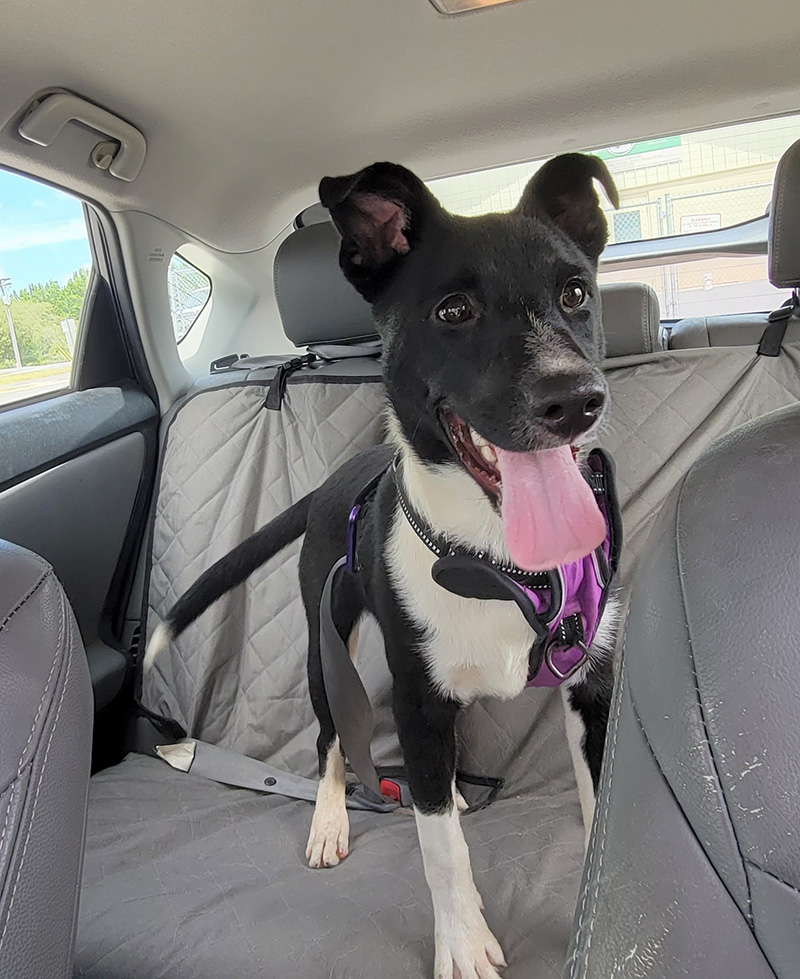
Mark had put our two dogs (Jaxon and Josie) in the backyard so that Fidget wouldn’t meet them yet. I was told by the rescue to keep my dogs away from him for several days to allow him to decompress. We took Fidget straight through the house into the shower before his urine smell could get on anything. He didn’t love taking a shower but he remained relatively calm, so it wasn’t too difficult. That night we kept him confined to our bedroom. If he was anxious about being there, he certainly didn’t let on – he just wanted to play and cuddle.
The next morning, I took Fidget out on a leash and started walking down the street. Then Mark brought out our cattle dog, Josie, and we started walking the same direction down opposite sides of the street. Josie was the big test, because she is often a bully to other dogs when she first meets them. But surprisingly she showed no signs of nastiness towards Fidget as we started walking them closer and closer together. It only took a few minutes before they were sniffing each other and then playing off leash in our backyard. After a little while we put Josie in the house and brought out our other dog, Jaxon (58 lb mixed breed who looks like a giant border collie), to meet Fidget and all went well with that too. So, we let Fidget in the house and he quickly started settling in to the routine. I feel that we were really lucky with how easily this all went. The only thing that was annoying about the 3 dogs together is that they were constantly humping each other in attempts to establish dominance. But over time, that mostly stopped.
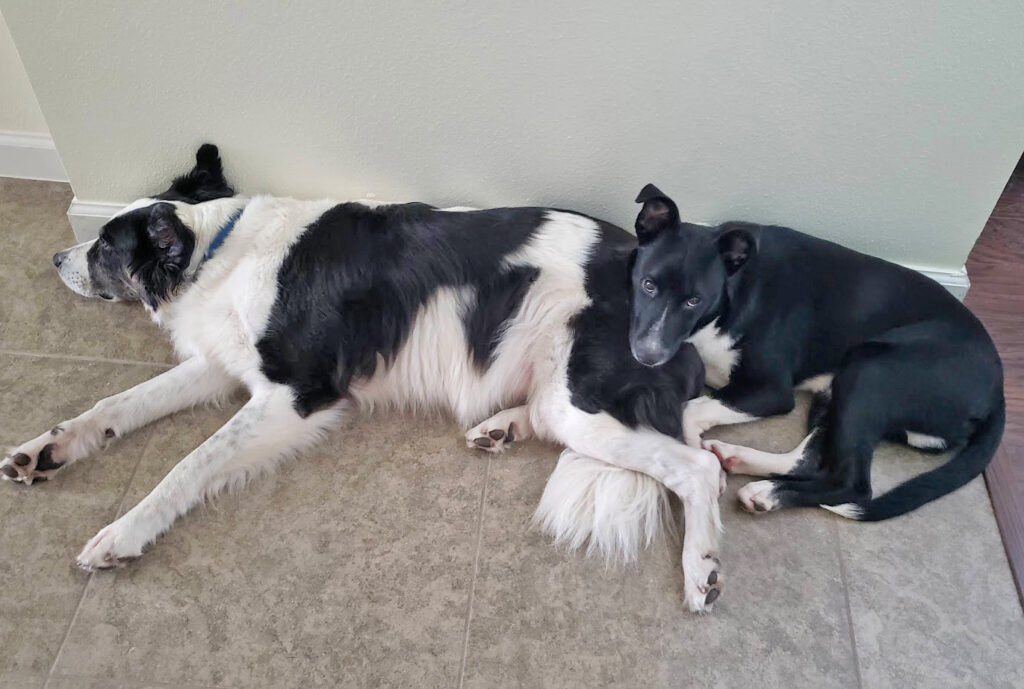

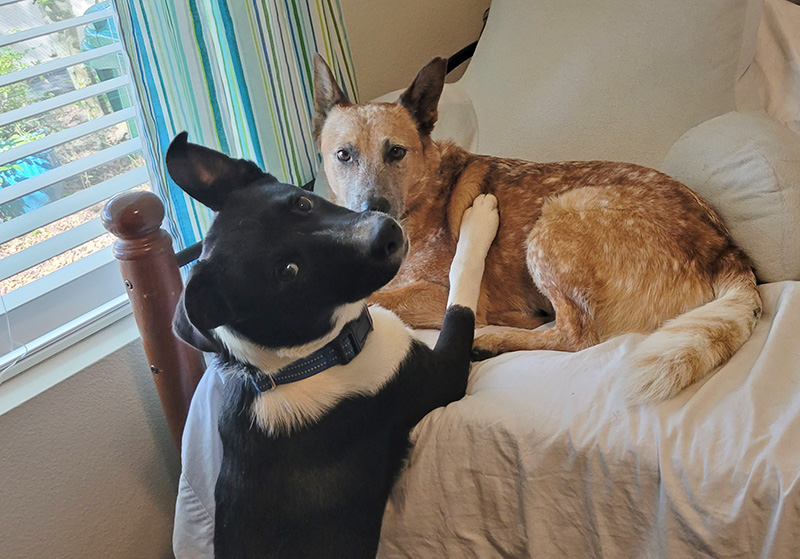
The first few days that Fidget was with us, he had several accidents in the house. I don’t know if he was ever house broken, but it certainly didn’t take him long to learn that it wasn’t OK to potty in the house. Luckily, we have a doggie door, and Fidget immediately learned how to use it. He only had to see Josie use it once, to get the idea. Within about a week Fidget’s “accidents” stopped. And again I felt that we got really lucky that Fidget was so easy to train.
The first thing that the rescue needed me to do for Fidget was to get him vetted. Unfortunately, the animal control shelter that I got him from did not provide any vet services other than to give him his first distemper shot. Since the rescue was paying for the vet bills, they had a say in what vet I used for Fidget and what type of care they would pay for. They gave me a couple of names of low cost vets and I was able to get him an appointment at one of them rather quickly (5 days after I got him). I took him to Florida Aid to Animals Palm Bay Office. It was a nice office but I can’t say that I was impressed with the vet services. For $125 we got the puppy package that included his required vaccines, a de-wormer, and an exam. Well, the exam was pretty much non-existent. They didn’t include a fecal exam and they discouraged me from getting one since he was getting a de-wormer anyway. But, the rescue asked for me to get it and so I did. The vet’s office called me later that day to tell me that Fidget tested positive for “a lot of hookworms” and I needed to come back and get medicine for him.; $65 worth of medicine as it turned out. So, why in the world didn’t they think it was important for a dog coming out of a rural shelter to get a fecal test? I waited a couple weeks and then had my dogs tested for worms, and unfortunately Josie tested positive for hookworms. So we had to pay for a deworming treatment for both our dogs.
While I was at Fidget’s vet appointment I asked the office for a neutering quote. The charge for neutering was only $120, but the catch was that there was a wait of approximately 5 months. I talked to the rescue about what to do and they said that we’d just put him up for adoption with a “neuter contract”. That means that the adopter would have to agree to get him neutered and they would give the rescue an additional deposit on top of the adoption “donation”. The adopter would get the deposit back after they provided proof of neutering. So Fidget was listed for adoption just one week after I picked him up at the shelter.
Now it was time to find Fidget his forever family. I bought a couple of “adopt me” scarves in hopes that someone would fall in love with him while we were out and about. I made a point of taking him with me wherever I could (wearing his scarf) to show him off and to get him socialized. I took him to home improvement stores several times, I took him to Petsmart and a dog-friendly book store. He even went out to eat with my husband and I one night. He behaved beautifully on all our outings, but on our very first outing (Lowes) he had an accident. We walked through the store shopping for awhile, and although he was a little skittish, he didn’t act out at all. But then we went out into the garden center, where he promptly pooped on the pavement. But I couldn’t be upset with him, he was clearly holding it until we got outside! Lol.
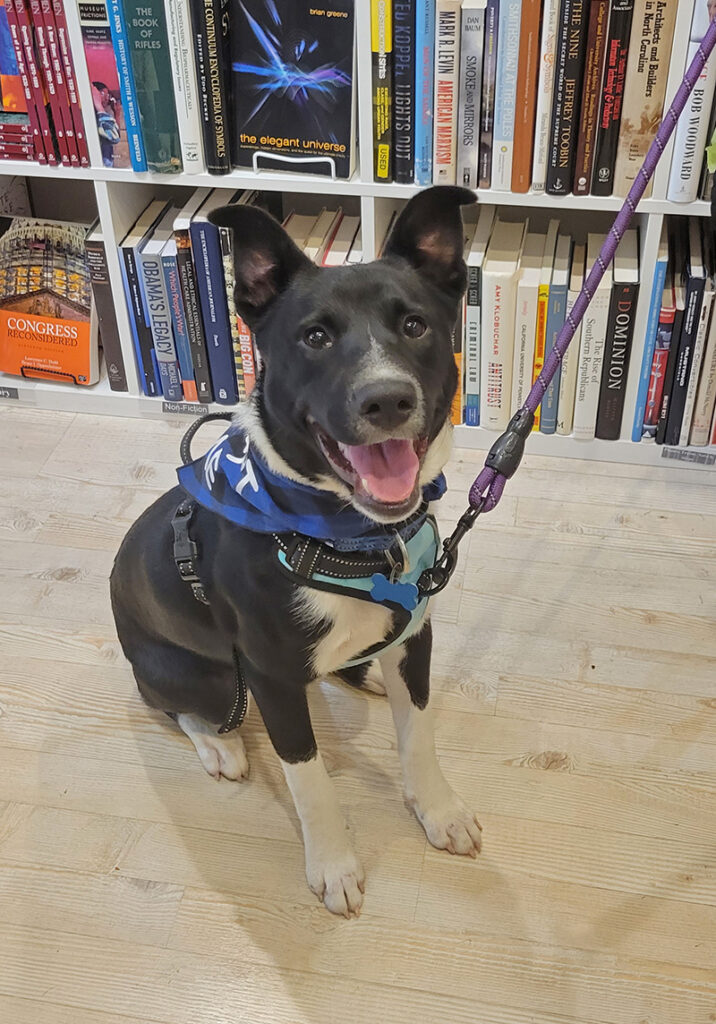
After just a few days of being listed for adoption, Fidget had his first inquiry. When someone would message the rescue about a dog without sending in an application, the rescue would reply to that person that they needed to fill out an application, but they would also forward me the person’s email in case I wanted to contact them. It was up to me to decide whether or not I wanted to wait for an application before talking to the person. I knew that without an application I might be wasting my time, but I wanted to give Fidget the best chance of getting adopted quickly so I contacted everyone who inquired about him.
The first person I talked to had already had an application approved by the rescue (not sure why they didn’t adopt at that time), but she was hesitant about committing to a high energy puppy when she already had one at home. The second person that inquired (I’ll call her Ellen) liked what I told her about Fidget, but she seemed a bit put off by the fact that he wasn’t going to be neutered. Regardless, she said that she was going to apply for him. But after several days went by and she didn’t apply, I started wondering if it was because he wasn’t neutered. I looked up the rescue’s adoption fees (“donations”), and realized that they charge the same amount of money to adopt a neutered dog as they do to adopt one that is intact. Plus, if the dog isn’t already neutered the adopter has to put down an extra $50 that they don’t get back until they prove they had the dog neutered (which the adopter has to pay for). That didn’t seem fair to me and I was afraid not being neutered would make it harder for Fidget to get adopted. So, I searched for other vets that offered inexpensive neutering. I got a quote from the vet that I take my dog to and they said it would be between $550 and $600. I knew that was way too much for the rescue to pay. I eventually found a place that would do it for a mere $90 and they only had a 2 week wait. So I contacted the rescue and got them to agree to get him scheduled.
Then I got another inquiry. This person lived in the same city as me (the others were all 2 or more hours away) and she wanted to meet him even though she hadn’t yet filled out an application. I wasn’t going to allow a meeting without an application, but then I realized her email was already in my email contacts. It turns out that I had met her before and that we had a mutual friend. Because of that I agreed to have her come over the next day. On the phone, she seemed really excited about Fidget but she was also very emotional as her dog had just passed away the week before. Well, by the time she arrived the next day, she had come to realize that she was acting out of grief and that she really wasn’t ready for a puppy. She told me this as she was getting out of her car. I was somewhat disappointed because I really loved the idea of Fidget getting adopted locally where maybe he could come over for a play date with Josie occasionally. I sat in the grass with the woman and Fidget and talked for awhile and she kept making comments about how attached he was to me. He just sat by my side and didn’t show any interest in her. After that I started worrying that other potential adopters would be put off by his attachment to me and his aloofness toward them. So I asked a friend to come over to do a practice “meet and greet”, while I tried to figure out the best way to introduce Fidget to potential adopters. That practice session went pretty well. I let Fidget loose in the backyard while my friend tried to engage him. Then I let Josie out to play with him and he seemed more at ease.
After I had Fidget for 6 weeks, I found out that Ellen (the person I spoke to who said they were going to apply but never did) was actually still interested. At about the same time, I had another inquiry from a women (I’ll call her Susan) who had a 7 year old dog and was looking to get a puppy. Both of these women submitted applications for Fidget just a couple of days before he was due to be neutered. So that meant any adoption was going to have to wait a couple weeks until he had a chance to heal. I felt that either of these women would be a good fit for Fidget, so I was potentially going to have to make a decision between the two. But In the end, I didn’t really have to choose because only one of the woman (Susan) was willing to make a commitment to adopt Fidget without first meeting him. (Of course, when she came to get him, if things went badly, she didn’t have to adopt him.) So I committed him to her and we just had to wait for Fidget to heal from his neutering.
The neutering went smoothly but it wasn’t easy trying to keep him calm while he healed. We had to keep him away from our dogs and he wasn’t supposed to jump because his stitches might tear. The jumping thing was a real issue because Fidget is a jumper. He jumped up when excited, and being a puppy, he was often excited. We were given some sedatives to help keep him calm. after his surgery. Those helped somewhat but not completely. In between his bouts of sleepiness he still wanted to play and jump. Of course he had to wear a cone, which made the playing awkward, but he pretty quickly got the hang of how to function with the cone on, although his initial reaction to wearing it was pretty pitiful (listen to the video). We tried him in an inflatable cone first, but as it turned out he could still lick his incision with that one on, so we had to switch to the traditional plastic cone of shame.

I would say that the 10 days that followed Fidget’s neutering was the most stressful/exhausting time for me. Up until then, he was pretty easy. He assimilated into our routine almost immediately, he learned basic commands with very little effort, and he kept himself entertained by playing with our other dogs. (The biggest issue I had with him was his need to attack me with love after being away from me for more than 5 minutes. You might think that sounds cute, but it wasn’t, and I have the scratches to prove it!) But after he was neutered we had to completely change our routine to keep the dogs from coming into contact with each other. And my husband or I had to always be in the same room with Fidget to make sure he wasn’t jumping on anything. And if we did leave him in a room alone, he would cry. Leaving the house became a big ordeal. We couldn’t crate him because of the cone. So we had to close him in a bathroom or the laundry room, but we had to puppy-proof the room first (ie. removed everything that he could jump up and reach).
So when Susan wanted to come get him a few days earlier than planned, I have to say I was quite relieved. I think having to deal with his recovery made the whole transition easier for me emotionally. She came with her 16 year old daughter and their 7 year old dog, Ranger. The big test was whether Ranger and Fidget would get along. She told me that Ranger was dog-friendly and I knew Fidget was definitely dog-friendly, so I wasn’t worried. But, unfortunately, the meeting didn’t go as smoothly as I had hoped.
I asked Susan to park in the driveway and call me when she arrived. She texted that they were there and that they’d start walking Ranger down the street. It took me a little while to put my dogs up and get Fidget on his leash, so I was surprised when I walked out the front door and Fidget started barking. They had parked in front of the house and were still getting stuff out of the car and Fidget felt threatened. So, my plan to meet down the street was foiled and Fidget didn’t make a great first impression. However, he settled down quickly as we started walking and he really wanted to meet and play with Ranger. But Ranger really didn’t have any interest in Fidget. After a short walk, we went back to the house and went through our gate directly into the backyard where we let the dogs off their leashes. Again, Fidget wanted to play, but Ranger just wanted to be left alone. Right after we let the dogs off leash, I heard Josie aggressively barking inside the house. I thought it seemed especially loud since I had put both Josie and Jaxon in my office, which did not abut the backyard. Well, as I peaked through the sliders into the living room, I saw that both dogs were right there trying to get outside. Apparently, Jaxon let them out of the office. (We have door handles instead of knobs and when he really wants to get out of room, he usually manages to.)
Jaxon was acting relatively calm, so I decided it would be ok to just put Josie back in the office and leave him in the living room. But when I opened the slider, Josie in her crazed state managed to push past me, and I fell to the ground shouting obscenities while chaos ensued all around me. The next thing I remember was grabbing Josie by her collar (which she slipped out of) and trying to pull her into the house while trying to detach Fidget from her back end. It appeared that Fidget was trying to put her in her place, while Ranger and Jaxon were just trying to stay out of it.
Once I got Josie in the office, I went back outside to find Susan clearly even more flustered than I was. After a few somewhat awkward minutes of trying to get Fidget to engage with her and her daughter, she asked if they could be left alone with Fidget and Ranger. So I went back in the house. After about 10 minutes when I went back outside, I acknowledged that the scuffle was uncomfortable but asked Susan what her specific concerns were. It was then that I learned that she thought Fidget had bitten Josie. I had noticed that Fidget had his mouth on Josie when I pulled him off, but I never thought he was biting her. So at that point, I went in the house and checked on Josie. I found where her fur was wet, but there was no blood or skin puncture. So I assured Susan that Fidget was just trying to keep Josie under control and had no intention of hurting her. But I didn’t get the sense that she was completely convinced. Susan asked me to let Jaxon out of the house to see how those 3 dogs (Fidget, Ranger & Jaxon) would do together. Clearly, she needed convincing that Josie was the actual problem, not Fidget. So after Jaxon came out without incident, Susan seemed to start feeling a bit better about the situation. However, she did ask me to confirm her understanding that I would take Fidget back if things didn’t work out for them at home. I agreed, but that question didn’t make me warm and fuzzy.
And so it was decided – Susan would take Fidget. While I was happy that things appeared to be working out, I was very disappointed that the happy adoption experience that I had imagined turned into a stressful, awkward ordeal. But Susan’s daughter was super excited about getting a puppy.
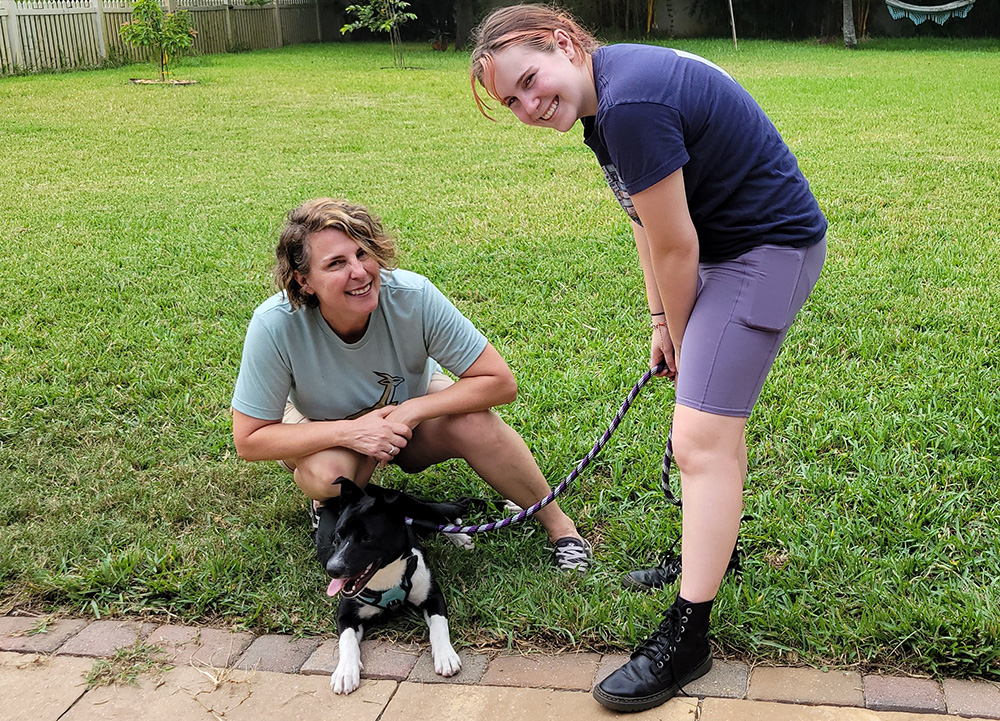
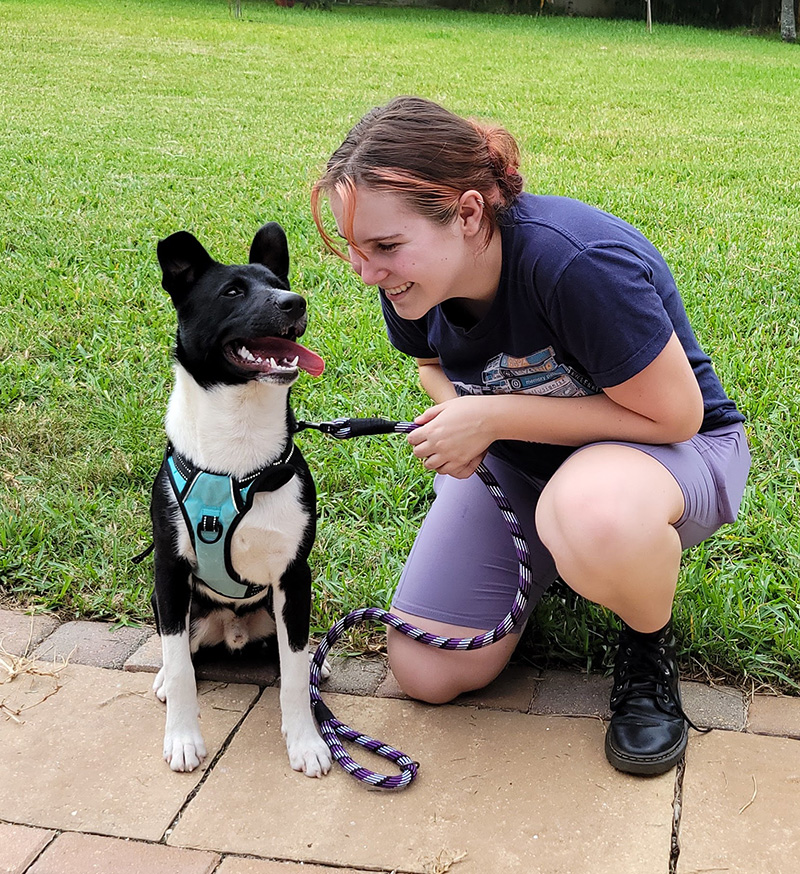
The story doesn’t quite end there. By mid-afternoon the next day I was kind of surprised that I hadn’t gotten an update on Fidget, so I texted Susan asking how he was doing. She replied that he was fine, but Ranger was not tolerating him being in the house, so she was having to confine Fidget to her bedroom. The following day Susan and I briefly spoke on the phone and it was clear that she was thinking she might have to return Fidget if things didn’t improve within a few days. I was quite disappointed. From my first conversations with her I really thought she understood that sometimes you have to work through these kinds of issues and they can take time. So for the next several days, when I heard nothing, I assumed things weren’t going well. But one week after she took Fidget I heard from her again saying that things seemed to be getting better. That was a relief. At the time of this writing, another 2 weeks has passed without a word, so I’ve started to assume Fidget really is adopted!
I have to say that the thing that I’ve liked the least about this fostering experience has been all of the uncertainty that came with it. Not knowing how long we were going to have Fidget made it very difficult to plan things out into the future. And that didn’t even end after he was adopted! Despite this, I’m glad I fostered Fidget and I’ll probably foster again sometime in the future. But based on this experience I will probably change the criteria for dogs I’m willing to foster. I’m thinking I’m going to only adopt dogs over a year old and ones that are already neutered/spayed. Based on this first fostering experience, I’ve created a list of what for me are the pros and cons of fostering.
The Pros and Cons of Fostering a Dog
Pros
- The enjoyment of a dog with a reduced cost and without a permanent commitment.
- The satisfaction of rescuing an abandoned dog.
- A potential playmate for your existing dog(s).
- An opportunity to get to know different breeds of dogs.
- If you a looking to adopt, you can “try out” the dog first by fostering them.
Cons
- Can be time-consuming and stressful, especially at the beginning.
- The uncertainty of not knowing how long you will have the dog.
- The disruption of your life and those who live with you.
- The cost. No matter how much the rescue provides you, you will ultimately incur some cost.
- Giving up the dog can be emotionally challenging for some people.
I hope this article has provided a little insight into what it’s like to foster a dog. Please use the comment section below if you have any questions or if you’d like to share something about your own fostering experience.

